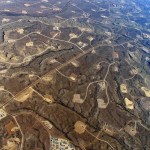Hydrofracking
Research makes it increasingly clear that along with drilling for oil and mining coal, extracting natural gas from deep underground causes serious damage to the environment and to public health. On The Pump Handle, Kim Krisberg examines the contamination that may result from dumping fracking wastewater into disposal wells, writing "about 1,000 different chemicals are used in the fracking industry, with more than 100 being known or suspected endocrine disruptors." Researchers collected water samples downstream from wells in West Virginia, and after "exposing both female and male mammalian sex…
A few of the recent pieces I've liked:
Jim Morris, Lisa Song and David Hasemyer in a collaboration between the Weather Channel, InsideClimate News, and The Center for Public Integrity: Fracking the Eagle Ford Shale: Big Oil and Bad Air on the Texas Prairie
Brigid Schulte in the Washington Post: 'Mad Men' era of U.S. family policy coming to an end?
Tom Frieden at The Health Care Blog: CDC: Together We Can Provide Safer Patient Care
Farida Jhabvala Romero at Reporting on Health: California County Seeks to Eliminate Health Safety Net for the Undocumented
Ted Genoways at OnEarth: Hog Wild:…
US industrial sand production increases dramatically, yet industry says worker protection too costly
By Elizabeth Grossman
Since the White House Office of Management and Budget’s (OMB) Office of Information and Regulatory Affairs (OIRA) began reviewing the Labor Department’s proposed rule to reduce by one-half the permissible workplace exposure to respirable crystalline silica more than two year ago, the US has seen a dramatic increase in industrial sand mining, a major route of workers’ exposure to silica dust. As Celeste Monforton reported for The Pump Handle on March 20th, OIRA’s review of the Occupational Safety and Health Administration’s (OSHA) draft proposed rule crystalline silica…
Over the past half-decade, the US has seen a sharp increase in high-volume hydraulic fracturing -- also called hydrofracking, or simply "fracking" -- to extract natural gas from underground shale formations. States' responses to fracking applications have varied, and in general public health concerns seem to have gotten far too little consideration.
The latest issue of the environmental and occupational health policy journal New Solutions is devoted to the issue of high-volume hydraulic fracturing (HVHF), and PDFs of all the articles are available for free online. It's a great resource for…
by Elizabeth Grossman
In response to results of the recently released National Institute for Occupational Safety and Health (NIOSH) field studies that found workers at hydraulic fracturing operations exposed to high levels of respirable crystalline silica, the Occupational Safety and Health Administration (OSHA) and NIOSH have issued a Hazard Alert. The alert outlines the health hazards associated with hydraulic fracturing and focuses specifically on exposures to airborne silica, saying that “employers must ensure that workers are properly protected from overexposure to silica.” It also…
The always-thoughtful Kurt Cobb has a great piece on the intersection between the hydrofracking boom and the mortgage mess:
One fact ought to tell you all you need to know about the risks faced by homeowners signing leases for natural gas drilling on their property: Wells Fargo & Company, both the largest home mortgage lender in the United States and a major lender to the country's second largest producer of natural gas, Chesapeake Energy Corp., refuses to make home loans for properties encumbered with natural gas drilling leases.
This salient fact comes from an article (PDF) written for…
